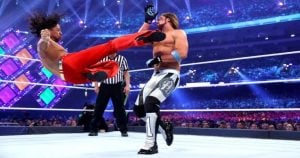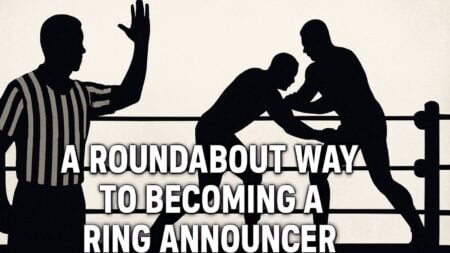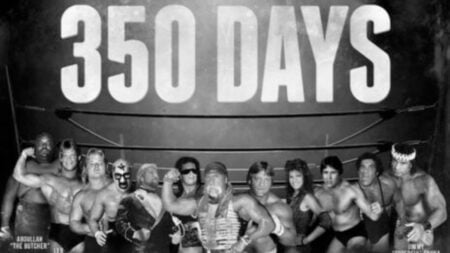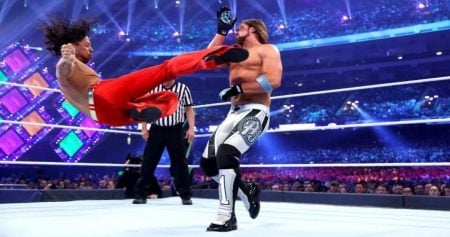Mitsuharu Misawa. Kenta Kobashi. Toshiaki Kawada. Akira Taue. Collectively they were known as ‘The Four Pillars of Heaven.’ They were the biggest stars of All Japan Pro-Wrestling during the 1990s.
Collectively they have one of the deepest and greatest catalogues of excellent wrestling matches in history. And today, we revisit the match that is widely believed to have started their famous main event run. This is the story of The True Beginning of the King’s Road, 12-03-93.
It’s the tag team match between Misawa & Kobashi and Kawada & Taue in the final of the 1993 World’s Strongest Tag Determination League (WSTDL) tournament.

The True Beginning of The King’s Road
Misawa and Kobashi vs Kawada and Taue
A Little Backstory
The WSTDL was AJPW’s annual tag team tournament that pitted the best duos in the company against each other. They fought in a round-robin tournament (so like NJPW’s G1 Climax, but for tag teams).
The winning team got a huge cash bonus and enormous trophies that showed the world how good they were. And in the late 1980s and early 1990s, AJPW’s World Tag Team titles were vacated before the tournament started so that new champions would be crowned in the final.
As for these four wrestlers, this match took place at the tail end of a one-year-long story and at the beginning of another. Since 1990, Misawa had been groomed to become the top star of AJPW, and Kawada had long been his right-hand man, his go-to partner.
However, to become the company ace, Misawa had to dethrone the existing ace, Jumbo Tsuruta. Misawa spent two years doing this, eventually succeeding in supplanting Tsuruta as the ace of AJPW.
And while Misawa warred with Tsuruta, his second, Kawada, had a bitter and bloody feud with Akira Taue. Those two had many brutal encounters during that same two-year span. On several occasions, they busted each other open the hard way because blading was all but banned in All Japan.
Then in September 1992, Tsuruta’s main-event wrestling career came to a screeching halt when he was diagnosed with Hepatitis. With Tsuruta no longer capable of main-eventing, AJPW promoter Giant Baba needed a new star to feud with Misawa for the coming years.
Thus, Baba, in a stroke of genius, took advantage of real-life jealousy and tension between Misawa and Kawada. On April 12th, 1993, after a 30-minute draw singles match, Kawada shocked the world by offering a handshake to Taue.
He broke away from his stablemate Misawa and formed an alliance with Taue. Thus, The Holy Demon Army was born.

Furious over this betrayal, Misawa vowed to defeat Kawada whenever possible. And with Kawada now his new arch-nemesis, Misawa needed a new right-hand man. Thus he elevated the much younger Kenta Kobashi – who had been the #3 partner in six-man matches that usually took the falls–, to being his #2.
Thus the stage was set for a huge encounter between this quartet of new stars.
An Important Aside
This match is much more important from historical and match-quality standpoints than their first encounter. These four wrestlers had their first two-on-two tag match on June 1st, 1993.
But that match, while great in its own right, was not in the same universe as this one and the ones that would follow. The fabled ‘Four Pillars style’ of AJPW matches had not matured back in June 1993. The match we’re looking at here, from December 3rd, 1993, is widely hailed as the first Four Pillars match.
The Match Begins
Things got off to a hit start from the very beginning. Each sequence was filled with twists and turns. Every time a move was hit, it was impossible to tell what was going to happen next.
Whether a wrestler would reverse a move, dodge it, absorb it and fight back, tag their partner in, or fight two-on-one, you never knew. Misawa and Kobashi took control quickly by landing some big moves on Taue. But that didn’t last long as Taue managed to counter Kobashi’s attacks and take over, and then tagged in Kawada.
Kawada was a vicious striking machine and dropped Kobashi with a brutal spin-kick soon after tagging in, but after landing it, he hobbled on one leg for a few seconds. That blink-and-you’ll-miss-it subtlety wasn’t for nothing, based on what happened later in the match.
Soon after, Kobashi became the hero in peril. Kawada and Taue took turns tormenting him with big move after big move after big move. They chopped him in the neck and chest with incredible force.
Kawada & Taue slammed him down, neck-first onto the mat and the ropes. They tried to keep him down, thinking they knew what it took to beat him because they were experienced. But Kobashi was a runaway freight train: you could keep putting roadblocks in his path, and he might slow down, but he won’t stop.
Things Kick Into High Gear
Kawada sensed this and decided to go a bit deeper and kicked Kobashi in the knee. This was a smart strategy as Kobashi was always an overachiever and loved to use both power moves like the delayed vertical suplex and aerial maneuvers like the diving moonsault.
And both of these moves but immense strain on his knees. So Kawada decided to go straight to Kobashi’s biggest weakness and attacked his knees.
But Kobashi didn’t go down like he had before. Instead, he returned the favor. He kicked Kawada in the knee. The same knee that gave Kawada problems during his opening attack. He was hobbling for a reason and hoped no one would notice too much. But Kobashi did.
Both men sank to one knee, but Kawada sank deeper and screamed out in pain. Then he just went to town on Kobashi, destroying him with knee strikes to the head. he even used close-fisted punches to the head, which were banned in AJPW.
So now, not only did Kobashi have to deal with a more experienced opponent in Kawada, but he had to deal with an angry Kawada as well.
But Kobashi was as also a quick learner. The sight of Kawada hobbling so much from one kick caused a light to go off in his mind. He immediately took Kawada down and punched the knee hard and fast.
Kawada tried to mount a comeback, but he was severely disadvantaged. His signature moves were kicks, so now he couldn’t really do much to damage his opponents, one of them being a human freight train and the other being Misawa.
But Kawada still showed steely determination and dropped Kobashi with a massive gamengiri kick to the face.
Taue vs. Misawa
With Kobashi’s face destroyed and Kawada, a one-legged man, it was up to Misawa and Taue to win the match for their respective teams. Taue took control of the match the same way he usually did: cutting corners and using underhanded tactics.
First, he dropped Misawa throat-first on any object he could, making it harder for Misawa to see what he was doing. Then, he and Kawada landed big double-team moves on him, including a big aided lariat and a brutal chokeslam/backdrop driver combo. All looked lost for Misawa.
But he managed to channel his inner fighting spirit and managed to overcome both of them long enough to tag in a now-recovered Kobashi. Kobashi weakened Taue considerably with his legendary stiff chops and even busted out the moonsault.
But it wasn’t enough for Kobashi to get the three-count, and Taue managed to tag in his partner.
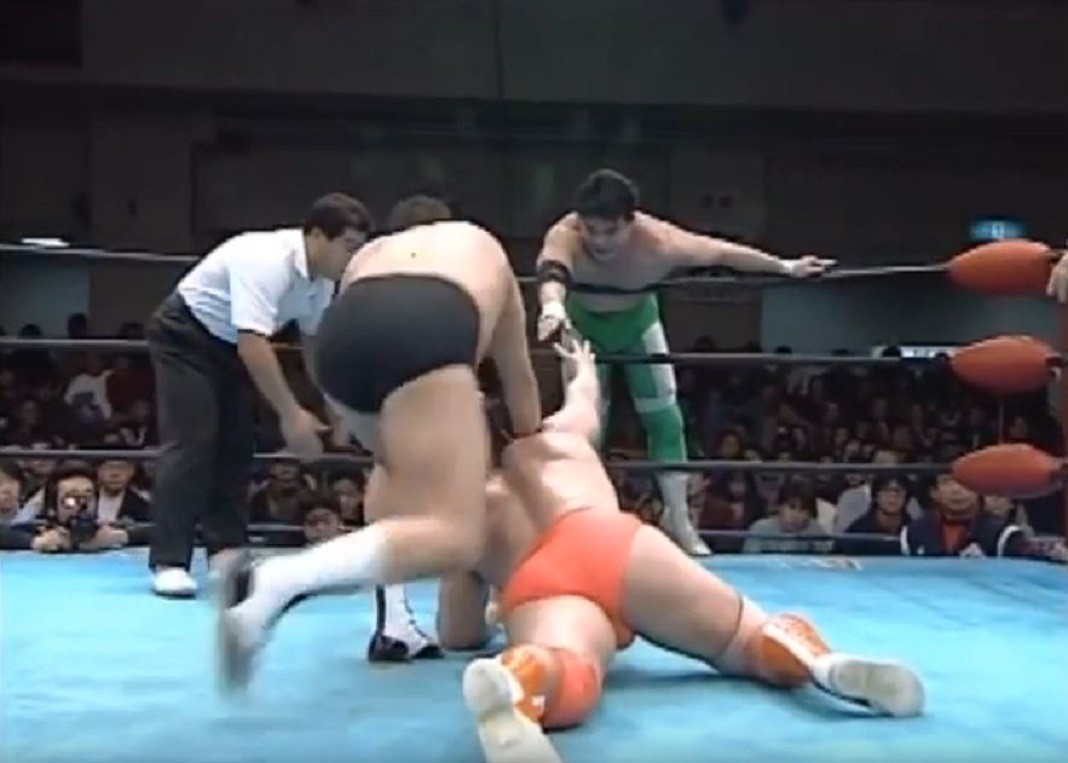
Misawa and Kobashi vs Kawada and Taue
A Legendary Third Act
Things between these two wrestlers immediately reached a peak as Kawada dropped Kobashi on his lead with a Backdrop Driver. Given that sick landing, that move should’ve marked the end of the match.
But Kawada couldn’t capitalize on it right away. His leg was causing him too many problems. He could barely even stand up, yet he continued the match. His actions were so convincing that it was impossible to tell whether his injury was real or just part of the match.
And even if it were real, the culture of AJPW was such that wrestlers worked through 99% of injuries since match stoppages were extremely rare.
Kobashi capitalized on Kawada’s slowness and tagged in Misawa, who immediately went back to work stiffing Kawada. Kawada tried to fight back, but even landing one spin kick grounded him.
Then he landed a Bridging German Suplex, which was a highly credible move in AJPW and was believable as a match-ender or at least a possible near-fall. But Kawada broke up his own pin because he couldn’t hold himself in the bridge. The pressure on his legs caused him too much pain to do so.
With no option to use power moves or strikes, Kawada resorted to a last-ditch effort, his Stretch Plum submission hold. It was a risk since wins via submission were rare in AJPW. But Kawada knew if he applied it long enough, Misawa would pass out from the pain.
Knowing this, Kobashi interfered to break up the hold, but Kawada never let up on the pressure. Then Taue came in and put his own sleeper hold on Kobashi, thus giving Kawada more time, but Kobashi’s power was too much for Taue as he broke free and saved his partner.
Desperate, Kawada went for his powerbomb finisher but couldn’t even hold Misawa up for a single second. It soon became virtually impossible for Kawada to do much of anything besides defend himself. But he still fought to the very end and kept using his lethal kicks, even if doing so caused him more pain.
In the end, Kawada was unable to make a dent in his opponents, and Kobashi scored the pinfall with, interestingly, a Backdrop Driver.
Legacy
This match is the King’s Road style personified. It’s a multi-layered wrestling match telling multiple interwoven stories while making a callback to previous matches. Kawada had knee problems going as far back as 1988, and those problems cost him that match as they did here.
But despite being something of a villain going into the match, Kawada’s desire to win by overcoming incredible pain made him into more of a hero instead. Sure he lost, but he looked so valiant in defeat that the loss did less harm than one would expect.
And, of course, this match’s decision led to more questions and possibilities for future match-ups. Now that Kobashi pinned Kawada in tag match, could he do the same in singles competition when he can’t rely on Misawa for help?
What will happen when Kawada heals up and is at 100%? Had Kobashi not interfered, would Kawada have beaten Misawa with the Stretch Plum? What sorts of strategies would Kawada and Taue bring into their eventual singles matches with Misawa?
These questions and more left fans guessing, which in turn made them want to buy more tickets and see the next show.
The beauty of this match and its kind is that it keeps the viewer guessing. You never knew what was going to happen. The twists and turns in the match made the match unpredictable while still making perfect sense in the context of the match’s story.
This match involved four incredibly talented yet unique wrestlers fighting for prestige while also trying to settle some personal scores. And they told these stories through a combination of stiff brutality, high-impact wrestling moves, straightforward psychology, and simplicity.
It’s the kind of match that one can enjoy just by watching it without understanding it. The action itself is simply incredible, and all the above details were just icing on the cake. This was the historic tale of the match between Misawa & Kobashi vs. Kawada & Taue on December 3rd, 1993.



